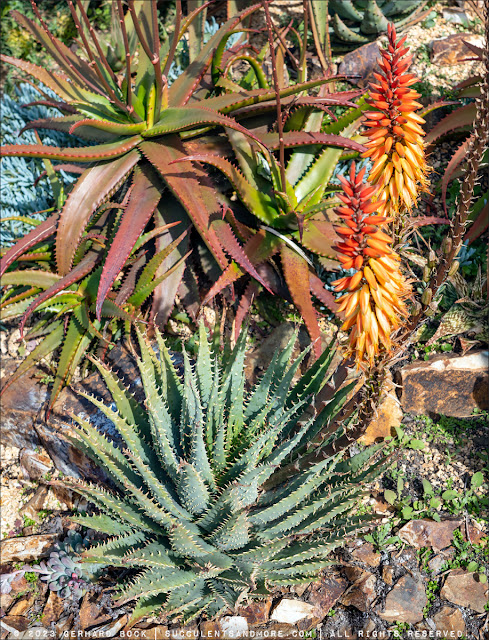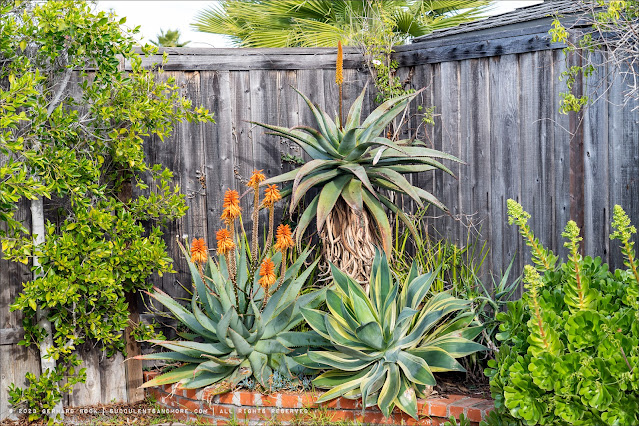One of the highlights of my recent San Diego trip was a return to Devon Boutte’s garden near La Jolla. I’d visited in February 2022, and I was curious to see how his aloes were doing in this weird winter.
In my garden, several aloes that flower reliably haven’t produced any inflorescences at all this year, and a few others have died outright from rot. In contrast, Devon’s aloes looked happy as can be, even though their flower development was behind where it had been during my visit a year prior.
 |
| Looking toward Devon’s house |
Devon not only collects aloes, he also makes his own hybrids. None of the aloes currently in the ground are his own creations, but I imagine that once they’re large enough, the best of them will find their way into his garden.
 |
| Planting strip between Devon’s and the neighbors’ driveway |
 |
| Aloe ferox with bicolor flowers |
 |
| Aloe peglerae × white-flowering ferox |
 |
| Aloe speciosa × white-flowering ferox |
 |
| Aloe speciosa in front of Aloe ferox × africana. The grevillea on the right is Grevillea ‘Kings Celebration’ |
 |
| Aloe ‘Swordfish’ in a sea of Sedum nussbaumerianum ‘Coppertone’ |
 |
| Aloe speciosa |
While virtually all of the larger succulents are aloes, Devon has tucked in a few choice agaves here and there:
 |
| Aloe ‘David Verity’ × white-flowering ferox (left), Agave attenuata ‘Kara’s Stripe’ (right) |
 |
| Agave attenuata ‘Ray of Light’ in the bed in front of the house |
I can grow many of the same plants in our garden, but because our climate is noticeably harsher (colder winters, hotter summers), I can’t quite achieve quite the same level of lushness. For one, the groundcover succulent Devon uses with great effect to knit everything together, Sedum nussbaumerianum ‘Coppertone’, struggles in Davis during the hottest months, its leaves periodically turning a crispy brown.
 |
Wider view of planting strip between the neighbors’ house
|
 |
| Main plantings in front of the garage and in the hell strip between the sidewalk and the street |
 |
| This is cramscaping at its best |
 |
| Aloe humilis × ferox, a Nick Deinhart hybrid |
 |
| Aloe elegans (in bloom on the left), Aloe pseudorubroviolacea (right) |
 |
| Hellstrip plantings: Aloe ortholopha × spectabilis, Aloe aculeata hybrid, Aloe castanea hybrid, Aloe lukeana |
 |
| Aloe aculeata |
 |
| Aloe lukeana |
In the backyard, room for plants is more limited. A good chunk is taken up by a swimming pool, and the patio off the living room is used for outdoor living and as a play space for the children. Still, Devon has crammed as many plants as he could into the existing planters in front of the fence. “The previous owners weren’t much into gardening,” Devon remembers, “and the planters were basically open, with the exception of a sickly Phoenix roebelenii that I removed.”
Here are just a few photos from the backyard:
 |
| Aloe ‘Tangerine’ (left), Aloe africana (middle), variegated Agave ‘Blue Flame’ (right) |
 |
| Aloe tauri, Aloe sabaea, Madagascar ocotillo (Alluaudia procera), Aloe vanbalenii, Aloe castanea × spectabilis |
 |
| Variegated Aloe africana |
When you look at the photos above, especially the front yard, you might think these plants have been there for a long time. Not so. Devon’s garden is just three years old. This is what the front looked like before (photos by Devon):
 |
| Before: February 2020 |
 |
| Before: February 2020 |
The front garden started as a pandemic project in February 2020. Working from home, Devon decided it was time to tackle the worn strips of grass in the front. They’d come with the house, which Devon and his wife had bought the year prior. Drawing on his expertise as a professional landscape architect, Devon quickly came up with an overall design and went to work, replacing the tired turf and foundation shrubs with a plant palette heavy on aloes and other succulents combined with select grevilleas and leucadendrons for texture and contrast. Working early mornings, evenings, and weekends, Devon says “it took about two months of solid work…all while still working 40-50 hours at my real job.”
It’s hard to believe that Devon’s garden is so young. Starting out with larger plants went a long way towards achieving a mature look more quickly. The Goldilocks climate of San Diego—as the crow flies, Devon’s house is just two miles from the Pacific Ocean—did its part. The result is succulent magic.
RELATED POSTS:
© Gerhard Bock, 2023. All rights reserved. To receive all new posts by email, please subscribe here.





































Mind blown! Lucky for you to show up when everything is blooming.
ReplyDeleteMy favorite photo is (#34) of the variegated Aloe africana, framed by the fabulous palm trunks, skirted by Coppertone" Sedum. It doesn't get any better than that.
Chavli
Agreed! I sure hope Devon's neighbors appreciate his garden the way we do!
DeleteWOW! It is mind blowing that this is year 3?! Exceptional garden, I'm incredibly jealous of the climate in the land of milk & honey. I think picking a favorite aloe would be impossible in this garden. Love this.
ReplyDeleteThat's what you get in a climate where plants are in active growth 365 days a year :-)
Delete3 years old ! That cramscaping shot is epic. I struggle too with S. nussbaumerianum -my issue is mostly related to cold. Such an effective use in this garden .
ReplyDeleteI have two clumps of Sedum 'Coppertone' and the similar 'Firestorm' at the base of our ponytail palms. They've done well there, protected against the worst of the cold and the ravages of the summer afternoon sun.
DeleteOh, yes please! A beautiful collection is right. I love San Diego, and I'll be there in September for a wedding. With family out there, there are more reasons to visit than ever. :)
ReplyDeleteFantastic! I'd love to have family in San Diego. My daughter is in Orange County, about 90 minutes north of San Diego proper.
DeleteFurther evidence that I need more aloes! That late winter garden sings. I love the Aloe aculeata hybrid and that Agave attentuata 'Ray of Light' looks fantastic. I look forward to seeing the Aloe lukeana you brought me in bloom one day - it's grown a LOT but it hasn't developed any of that rich orange color (not stressed enough maybe), much less flowers. I adore the Cheiridopsis candidissima - I've sadly ignored those smaller groundcover-type succulents far too long.
ReplyDeleteI think Devon's garden is proof that you can't ever have too many aloes :-)
DeleteI have two Aloe lukeana. They're fairly large now, but neither of them has flowered yet. The flowers are spectacular!
I bought Cheiridopsis candidissima in 1 gallon size at Plant Depot in San Juan Capistrano, so it is in the trade.
Sedum nuss 'Coppertone' does fine for me in Long Beach, and S. adolphii is good too. The rhythm of the big rosettes with shrubs and GC is so good -- and with the aloes in bloom, it doesn't get any better.
ReplyDeleteI would imagine anything that grows well in San Diego would also grow well in Long Beach.
DeleteYou are right, it is absolutely magical! Thank you for sharing.
ReplyDeleteI wonder if the agave on photo number 32 (on the right side) could be an Attenuata Ray of light, rather than a Blue glow?
Ceylân, you're welcome! I do think it's a variegated 'Blue Glow' rather than attenuata. The leaves are stiffer than attenuata. But I will double-check with Devon.
DeleteI love how Devon paid attention to the ground level using the sedum to knit everything together. Truly a spectacular garden and far more interesting than those little strips of grass were.
ReplyDeleteYes, Devon paid attention to everything. Having a Master's degree in landscape architecture definitely helps :-)
DeleteBeautiful plants, and attractively landscaped. Winston
ReplyDeleteOh, to be Devon's neighbor and look at his garden every day! Thanks to much for a visit again to see it, Gerhard!
ReplyDeletePuts my front slope to shame. Fabulous!
ReplyDelete4th photo from the end--sure that is van balenii?
Sedum 'Coppertone' is troublesome here where its not nearly as hot as further inland. Here it's happiest in 75% shade with regular water--not a heat/drought lover! That color is so spectacular with 'Blue Glow' I keep trying and failing.
Am uneasy--of mixed feelings--about Aloe hybrids, even though a few are obviously wonderful--'Hellskloof Bells' comes to mind--and natural hybrids certainly occur in the wild. Something about the tens of thousands of years of evolution born in a pure species is to be admired. Something like that.